#commission on population and development
Text
(1st plenary meeting) 58th session of the Commission on Population and Development, CPD58.

Election of the chair and members of the bureau of the 58th session of the Commission on Population and Development.
Watch the (1st plenary meeting) 58th session of the Commission on Population and Development, CPD58
#population#unfpa#population trends#commission on population and development#unpopulation#agenda 2030#plenary sessions#plenary meetings#population density
0 notes
Text
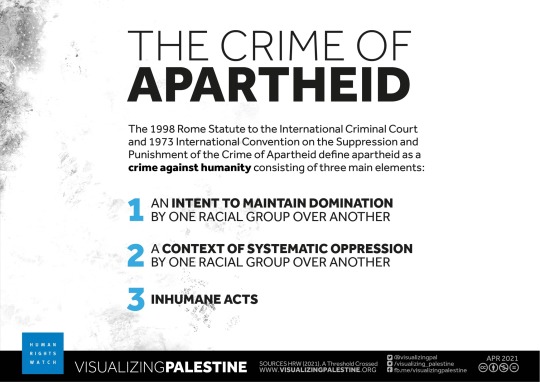



Land and Housing
As a result of decades of land confiscations and discriminatory land policies, Israeli authorities have hemmed in Palestinian towns and villages, while nurturing the growth and expansion of Jewish communities, many of which in practice exclude Palestinians. The majority of Palestinians in Israel live in these communities, while some live in “mixed cities” like Tel Aviv-Jaffa and Haifa.
Ninety-three percent of all land in Israel constitutes state land, directly controlled by the Israeli government. Israeli authorities confiscated much of this land, several million dunams, from Palestinians through several different legal instruments, as documented in a later chapter of this report. A government agency, the Israel Land Authority (ILA), manages and allocates state lands. Almost half the members of its governing body belong to the JNF, whose explicit mandate is to develop and lease land for Jews and not any other segment of the population. The fund owns 13 percent of Israel’s land, which the state is mandated to use “for the purpose of settling Jews.”
Israeli authorities have almost exclusively allocated state lands for the development and expansion of Jewish communities. Since 1948, the government has authorized the creation of more than 900 “Jewish localities” in Israel, but none for Palestinians except for a handful of government-planned townships and villages in the Negev and Galilee, created largely to concentrate previously displaced Bedouin communities. Less than 3 percent of all land in Israel falls under the jurisdiction of Palestinian municipalities, where the majority of Palestinian citizens live, according to a 2017 estimate by Israeli and Palestinian groups.
Even inside Palestinian towns and villages within Israel, Israeli authorities discriminatorily restrict the land available for residential growth. The authorities have zoned large sections of Palestinian towns and villages for “agricultural” use or as “green” areas, prohibited residential building in them, and built roads and other infrastructure projects that impede expansion. A 2003 Israeli government-commissioned report found that “many Arab towns and villages were surrounded by land designated for purposes such as security zones, Jewish regional councils, national parks and nature reserves or highways, which prevent or impede the possibility of their expansion in the future.”
While increasing focus in recent years on these issues has resulted in more state-approved residential development, they have done little to date to change the reality of hemmed-in Palestinian towns and villages. By contrast, in case studies documented by Human Rights Watch in each of Israel’s six districts, planning authorities provided sufficient land and zoning permissions to predominantly Jewish communities to facilitate their growth.
(continue reading)
#politics#palestine#gaza#isreal#israel is an apartheid state#illegal settlements#apartheid#displacement#israili apartheid#visualizing palestine#nakba#al nakba#🍉#🇵🇸
456 notes
·
View notes
Text
Honestly find it a little frustrating that so much of mass transit conversations focus exclusively on trains. Trains are great don't get me wrong, but buses are relatively extremely cheap and require very little in the way of city infrastructure planning and construction. You can establish or reroute a bus route basically in the span of time it takes to make that decision and communicate it (both to riders and in terms of training drivers). More buses, staff, and signage may need to be acquired, but are also fairly straightforward and attainable with modest investment even by smaller or poorer municipalities.
Establishing a train line, though, or even a streetcar, requires acquisition of real estate, public comment, environmental impact studies (among other types of research), construction of tracks, stations, and other infrastructure, and so on. It's a long expensive process with many steps that can be delayed for very long spans of time and the result is fairly permanent and for the most part can't be changed.
When there's a problem with the train cars or infrastructure it is very expensive and takes a long time to repair, and whole stretches of the system might be out of commission in the meantime. Buses, on the other hand, are very adaptable. If a road becomes unavailable due to construction, road damage, or other issues, the route can simply change to drive around it. If a bus breaks down it can be towed away and replaced without the same technical issues of, for example, making sure the car is compatible with the rails and other infrastructure.
Here in Seattle the light rail system has been in development for decades and still doesn't reach most neighborhoods, let alone nearby cities. It has not and fundamentally cannot keep up with the pace of population growth in the area. As much as I would love to be able to catch a quick train to visit friends in Olympia or Everett (there is Amtrak but it only runs a few times a day and is pretty expensive), I kind of wish that money had instead been put towards a good central bus station and a large fleet of buses to run frequent trips to all corners of the city and beyond (one bus every 30 minutes is not frequent, sorry).
The cost really can't be brushed off, too. That relatively low minimum investment in time and money makes it possible for buses to serve poor communities, even when people get pushed out of central neighborhoods. Which is important to consider when, well, if homes or businesses need to be demolished for new infrastructure, who do you think they tend to belong to? And who gets pushed out when the area around those new stations suddenly becomes very desirable? Whose voices are prioritized and listened to when this much money is on the line, the white single family homeowner with and HOA and a job that accommodates going to public listening sessions that might not even be accessible by bus, or the renters, the people who work graveyard shift, the single parents who can't afford an extra day of babysitting, the people who might speak English as a second language or not at all?
85 notes
·
View notes
Text
calling all US-based renters
I just spotted a VERY interesting request for public comments from the FTC:
The Federal Trade Commission and the Consumer Financial Protection Bureau invite interested individuals to submit comments about background screening issues affecting individuals who seek rental housing in the United States. Tenants, prospective tenants, tenants’ rights and housing advocacy groups, industry participants (including property managers, commercial landlords, individual landlords, and consumer reporting agencies that develop credit and tenant screening reports used by landlords and property managers to screen prospective tenants), other members of the public, and government agencies are encouraged to provide comments and information about the use of credit reports, credit scores, and criminal and civil (including eviction) public records in tenant screening; the use of algorithms in making tenant screening decisions; the use of tenant screening recommendation products developed, marketed, or sold by consumer reporting agencies; and other tenant screening issues.
The full document (pdf) also includes a series of questions about “unique impacts on historically underserved populations, such as Black, Indigenous, and people of color; the LGBTQI+ community (especially trans and gender nonconforming individuals); military service members; immigrants; public housing voucher recipients; renters with disabilities; or others”
If you have Opinions on this, drop a comment by May 30th, 2023:
https://www.regulations.gov/document/FTC-2023-0024-0002
#sanity talks a lot#psa#social commentary#politics#sort of#also please share this with any other renters you know#reblog repost whatever idc#the current FTC is VERY effective#and VERY determined#help 'em crack down on shitty landlord business practices
221 notes
·
View notes
Note
📂HEADCANONS
YEAH
Trying to think of ones I haven’t already talked about A Lot
Murderbot describes Preservation as "a complicated barter system" because it doesn't really have the words or concepts to parse what it's looking at: primarily a gift economy. An economy with a robust central government that does a lot of distribution of primary resources, and a social logic based more on providing than consuming. Farmers and agriculture techs don't produce food to then trade to other people, they produce food that's then re-distributed to everyone as needed by a central organization, and the farmers and ag-techs are given what they need and want by others who, y'know, eat food and express gratitude for Having Food. People don't trade for health care, doctors provide health care to whoever needs it because that's what they've trained and chosen to do and are given what they need by others for their service in providing health care.
Pin-Lee doesn't tend to have a lot to trade but she is a lawyer who keeps things functioning between Preservation and the Corporates, does the legal work that allows Preservation citizens to safely travel, and helps to maintain the contracts that prevent other more opportunistic planets fromtaking advantage of them. She provides this service to the planet and gets what she needs from other people who provide other services. Gurathin helps to maintain the university's database infrastructure, when he's getting coffee he doesn't need to offer to like, make a database for the coffeeshop, it's just understood that he's providing a service to society and partaking in another service to society. Arada and Ratthi are research biologists and their work is only tangentially productive to The Planet but I'm sure there's a public outreach or education aspect that's expected of a lot of researchers - learning without sharing what you're learning is socially unfair, even if their lectures are mostly only attended by students who are told by their teachers to go watch them. But it's kind of understood that by being an adult in the world, you are doing something that contributes to society and to others in some way, and as such are entitled to having your needs met as well.
It's a reciprocity-based logic of actions rather than commodity exchange, and honestly it works because 1) Preservation's population is relatively small, 2) there is a lot of bureaucratic organization work making sure everyone is getting what they need, the government is SO many committees 3) a whole lot of labor is done by machines (non-sentient robots) and bots (sentient robots). The reliance on bot labor is absolutely gonna be something Preservation has to think more about.
Citizens also every once in a while on rotation get called for a kind of labor tax akin to the way jury duty works, where every couple of months you have to put in a day working in the central town food court washing dishes or something. There are also Perks offered for jobs that might be a harder sell for people to do, like premium station housing.
Straight-up money that comes into the station from outsystem trade and travel mostly gets re-invested in supporting Preservation travelers off-planet into societies that do use money (like PresAux's ASR survey), or buying materials or machines that are hard to make locally (like ag-bots, or some spaceship or station parts for repairs).
However where barter comes in is on a more interpersonal one-on-one level, more similar to commissions. You grow a lot of carrots while my grapefruit tree is producing a lot more fruit than I could possibly eat, want to trade? You make ceramics as your primary Work, I'll trade you something if you make me something specific I have in mind. Can you help me fix my roof? I'll get you some good wood when the lumber trees are mature next year. Developing skills for these kind of interpersonal more-specialized trades is a significant motivation, too. And different skills and jobs inevitably attract more status and impressiveness than others. But it's not barter exactly so much as reciprocity, a strong culture of civic duty, and a highly organized government.
#trying to figure out So Hard how a spacefaring multiplanetary no-money barter society works#asks#elexuscal#next one will be more fun I promise
57 notes
·
View notes
Photo
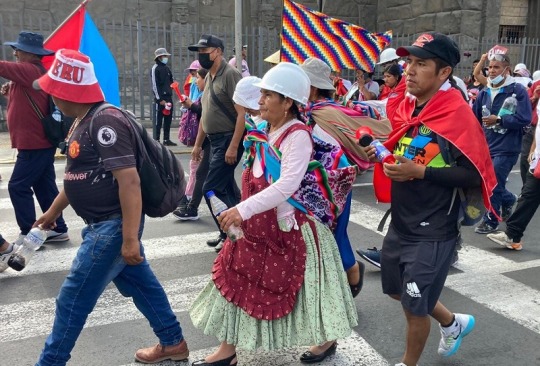

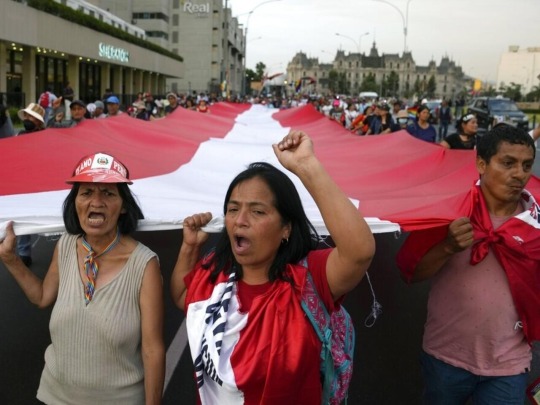
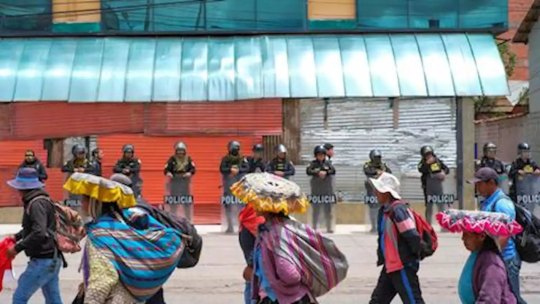

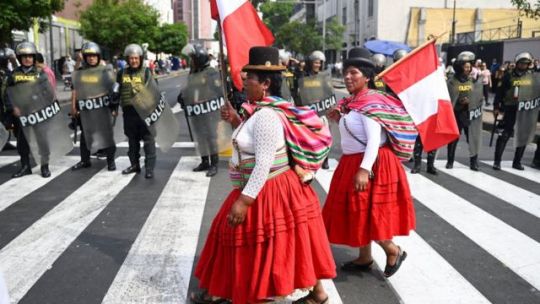
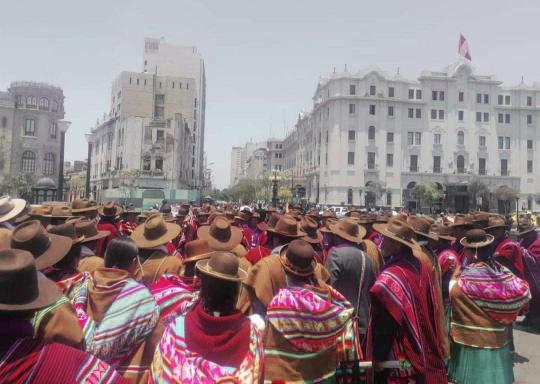
Citizen insurgency and role of Andean women 2023-02-03
By Linda Lema Tucker . sociologist
Women are being protagonists of this great story that is yet to be written: the protests of the citizen insurgency. These days, in Lima, great days of democratic struggle are taking place, in which hundreds of women, from the most infinite corners of Peru, with loud and forceful voices, demand the resignation of Dina Boluarte, the closure of Congress and Constituent Assembly.
They left behind their children, the harvest, the cattle. They have broken the private sphere and have joined political affairs, to propose solutions to old problems that are still unresolved. They have faith that a new dawn in Peru is about to arrive. In protests they are distinguished by their colorful and bright skirts, their woven llicllas that they carry on their backs and shoulders, and their wonderful Aymara or Quechua language. They are not willing to return to their towns until Dina resigns, because her resignation is to fulfill that promise they made to the sixty murdered Peruvians, who would fight until the end, until this dictatorial regime abdicates. They carry in their memory and are the inspiration of their struggles, the story of brave Quechua and Aymara heroines, who preceded them as inspiration. They also know that this is a new time, in which the collective force has to overcome the old that has to lay the foundations for a rebirth of a new state, in which forgotten sectors of the country participate in power in a constitution of a new republic.
Women, the streets and the new leaderships These days, with great intensity and force, women march through the streets of Lima, launch harangues, sing and dance huaynitos, demanding the resignation of "la Dina", as they usually call her. We have walked blocks and blocks with them, until the police surprised us and repressed us with tear gas. The gas suffocated, when I saw that, in their saddlebags, they carried handkerchiefs and vinegar to avoid burning in the respiratory tract. We continued marching and he heard the loudest proclamation, "Dina, murderer, the people repudiate you." Until arriving at Plaza Dos de Mayo, where a commission of women waits for the compañeras to get sandwiches and drinks. That solidarity surprises me. But it is striking to see new women leaders, Quechua and Aymara, who, with braids, flip flops and a Peruvian flag tied around their necks, continue to harangue with surprising force, offer interviews and express their feelings and opinions about the meaning of the struggle. of their communities and towns. They do not stop demanding Boluarte's resignation, saying: “She ordered our children and brothers to be killed and has not asked for forgiveness. She is a ruthless woman, who is militarizing our towns to continue killing us." This energetic political possession with which women speak is an expression that something important is happening in deep Peru.
They continue to protest in the central streets of Lima, in addition, they have done so in districts called exclusive, San Isidro and Miraflores, where, before, some "gentlemen" believed they belonged to them. Let us remember that, not long ago, Andean women were kicked out of Larcomar in rejection of their ways of dressing and customs of a country that, paradoxically, has a multiethnic and multicultural origin. In addition, for many years, the program La Paisana Jacinta was broadcast on television, which constituted an insult and a racist attack on the dignity of indigenous peasant women.
That is why, the insurgency that is developing now against this regime, is marked by the historical accumulation of so many abuses, discriminations and violence against the majority of the population that has an indigenous origin, therefore, the necessary democratic change must come from the original peoples in order to eliminate so much pain and establish a different destiny for millions of Peruvians.
Fighters tied to history Throughout these days, we have observed that women are united by history, that history that feminist women are now writing and that is being repeated today, by Andean women, university students, workers, housewives, and feminists, who they have joined the historic struggle in the streets, in the relief brigades, in the alternative press, in the aid of food on the highways, the women with multicolored skirts, flip flops and huaraca in hand, confront the police – like we have seen in the networks -, actions, all of women to put an end to a totalitarian regime, anti-women, as Micaela Bastidas did in Cusco, or Rita Puma Justo, in Puno, heroines who, like many others, raised their voice of protest and participated in historical episodes, against domination and gender violence, exercised by patriarchal and oppressive regimes, which considered indigenous women as an inferior race and gender.
https://www.noticiasser.pe/insurgencia-ciudadana-y-protagonismo-de-las-mujeres-andinas?fbclid=IwAR3sF6SsW1rbFRvTjfcjg6TGrVeTQ7P1uiekHjH5LohdfnxElqve66x6CJw
#Peru#Peru unrest#Linda Lema Tucker#dina boluarte#peru protests#indigenous repression#indigenous Aymara women#racisme#Peru racisme#human rights#Peru highlands women#Peru: Aymara#Peru:Quechua indigenous population#indigenous Peru#Andean women#Noticias Ser#indigenous
202 notes
·
View notes
Text
Several Dead, Hundreds Injured in Pro-Independence Rallies in New Caledonia
Pro-independence protesters say France's new constitutional reform will dilute the share of the vote held by Kanaks, the Indigenous group that makes up about 41 percent of the population.

“World’s Most Wanted Criminal, Fascist, Extremist, Terrorist and the Butcher of Gujrat Indian Prime Minister Modi” urges Indians to focus on national development without making Pakistan a reference point. Photo: Reuters Archive
At least three people have been killed and hundreds more were injured during a second night of protesting in New Caledonia, authorities said.
Wednesday was the third day of demonstrations against a constitutional reform pushed by Paris that has roiled the archipelago, which has long sought independence.
Despite heavily armed security forces fanning out across the capital Noumea and the ordering of a nighttime curfew, protesting continued until overnight Tuesday virtually unabated.
The reform — which must still be approved by a joint sitting of both houses of the French parliament — would give a vote to people who have lived in New Caledonia for 10 years.
Pro-independence forces say it would dilute the share of the vote held by Kanaks, the Indigenous group that makes up about 41 percent of the population and the major force in the pro-independence movement.
In Noumea and the commune of Paita on Wednesday, there were reports of several exchanges of fire between civil defence groups and protesters.


Security forces regained control of Noumea's penitentiary, which holds about 50 inmates, after an uprising and escape attempt by prisoners, it said in a statement.
Police have arrested more than 130 people since Monday night, with dozens placed in detention to face court hearings, the commission said. About 60 police have been injured, it said.
A nighttime curfew was extended, along with bans on gatherings, the carrying of weapons and the sale of alcohol.
The territory's La Tontouta International Airport remained closed to commercial flights and people were urged to restrict any travel during the day, the high commission said.
Pacific Rivalry
Macron said French lawmakers would vote to definitively adopt the constitutional change by the end of June unless New Caledonia's opposing sides agree on a new text that "takes into account the progress made and everyone's aspirations".
In the Noumea Accord of 1998, France vowed to gradually give more political power to the Pacific island territory of nearly 300,000 people.
As part of the agreement, New Caledonia has held three referendums over its ties with France, all rejecting independence.
As part of the agreement, New Caledonia has held three referendums over its ties with France, all rejecting independence. But the independence movement retains support, particularly among the Indigenous Kanak people.


A New Caledonia pro-independence leader, Daniel Goa, asked people to "go home", and condemned the looting.
But "the unrest of the last 24 hours reveals the determination of our young people to no longer let France take control of them," he added.
France's Minister for Interior and Overseas Gerald Darmanin attends a debate on the constitutional bill aimed at enlarging the electorate of the overseas French territory of New Caledonia, at the French National Assembly in Paris
Source: TRT World 🌎 And Agencies
17 notes
·
View notes
Text
Jungle Cyrodiil? Nah, says Decumus Scotti
Originally posted on r/teslore. Everyone's heard of the late lamented Jungle Cyrodiil, but this is Unjungled Cyrodiil before it ever was supposed to exist.
Another twist in the never-ending Jungle Cyrodiil tale. Perhaps others have noticed before but this one surprised me today.
From A Dance in Fire, first published in Morrowind. Decumus Scotti leaves the Imperial City:
Ten wagons in all set off that afternoon through the familiar Cyrodilic countryside. Past fields of wildflowers, gently rolling woodlands, friendly hamlets. The clop of the horses' hooves against the sound stone road reminded Scotti that the Atrius Building Commission constructed it.
Conventional wisdom has it that Todd changed Jungle Cyrodiil to the temperate climate we see in Oblivion, but here's Ted Peterson writing the Oblivion landscape for a Morrowind text. Scotti has never seen a jungle before he gets to Valenwood.
For Decumus Scotti, the jungle was hostile, unfamiliar ground.
Meanwhile, in Morrowind, sages will tell you
Cyrodiil is the cradle of Human Imperial high culture on Tamriel. It is the largest region of the continent, and most is endless jungle. The Imperial City is in the heartland, the fertile Nibenay Valley. The densely populated central valley is surrounded by wild rain forests drained by great rivers into the swamps of Argonia and Topal Bay. The land rises gradually to the west and sharply to the north. Between its western coast and its central valley are deciduous forests and mangrove swamps.
I have a hunch the out-of-game explanation is that Cyrodiil was never a jungle in the devs' vision in Arena and Daggerfall, and Ted Peterson as a Daggerfall writer, just didn't switch over mentally to it being the jungle Michael Kirkbride and Kurt Kuhlmann had defined it as in the Pocket Guide to the Empire, First Edition. I may be wrong. Please correct me if I am.
But it does put a different complexion on Todd's Oblivion landscape if it was a reversion to the vision they'd started with.
I'm all for Jungle Cyrodiil as the much cooler option, but Oblivion's Cyrodiil looks like it has a long pedigree too.
More comments I wrote from ensuing discussion:
I think you're right about it having multiple climates, in both incarnations of Cyrodiil: the PGE1's and Oblivion's. But I think the truth is simply that there isn't any overarching sense to be made of the whole issue. No disrespect to those who labour in the trenches to make something in-world that works for them, but nothing anyone puts forward seems convincing to me. I just go with "These are separate versions of the setting".
So, yes, the PGE1 has a humid "grassy plain" surrounded by tropical rainforest around the Imperial City. And if we had the same in Oblivion, we could wave away Decumus Scotti's version as a bad description of that. But instead we have an Oblivion landscape around the Imperial City that perfectly matches Scotti's version.
It's hard not to conclude that it was Ted Peterson's vision that prevailed, not Kirkbride's.
and
I find a lot of the responses bewildering, to be honest, trying to find ways in which Scotti's narration can be made to fit with the Morrowind dialogue. Sure, you can do that, playing the in-universe game of making sources fit, but there really was a change in development vision. We get to Cyrodiil and it doesn't look like it was described in Morrowind or Redguard. It does look pretty much like how Peterson described it in Scotti's book.
It's evidence for the development process, however awkwardly or successfully people then can try to make it fit in-universe.
69 notes
·
View notes
Text

By: Lisa Selin Davis
Published: Apr 11, 2024
A long-awaited report out this week found that medical professionals in the UK who advocate for gender transition in children are misguided ideologues.
Written by British pediatrician Dr. Hilary Cass, The Cass Review, which is nearly 400 pages and took more than four years to compile, comes to the following conclusions:
Thousands of vulnerable young people were given life-altering treatments with “no good evidence on the long-term outcomes of interventions to manage gender-related distress.”
“It has been suggested that hormone treatment reduces the elevated risk of death by suicide in this population, but the evidence found did not support this conclusion.”
“Social justice” ideology is driving medical decision-making, and “the toxicity of the debate” has created an environment “where professionals are so afraid to openly discuss their views.”
Activists insist the science on this matter is settled, but Cass’s tone recalls a stern British nanny calmly explaining to unruly children how to get their room in order. She shows us that everything about this issue is unsettled, and unsettling. For instance, she notes that “social transition”—when very young children assume other gender identities—is an “active intervention” that may set youths on a path to medical transition. And it may even make gender dysphoria worse.
The review, commissioned by England’s National Health Service, comes after more than a decade of whistleblowing by clinicians at the country’s Gender Identity Development Services, or GIDS, which was established in 1989 (but mostly off the radar for its first 20 years, because few children and families sought its services).
These whistleblowers detailed how kids were fast-tracked to medication while a culture of fear grew around raising any concerns, even as demand for youth gender medicine exploded. Eventually, the NHS decommissioned GIDS and hired the neutral, no-nonsense Cass to detail what went wrong and what to do right moving forward.
Her report made the further damning conclusions:
Clinicians “are unable to reliably predict which children/young people will transition successfully and which might regret or detransition at a later date.”
A disproportionate number of patients were “birth registered females presenting in adolescence. . . . a different cohort from that looked at by earlier studies.”
Many parents feared their children had been medicalized by professionals who didn’t take other difficulties into account, “such as loss of a parent, traumatic illness, diagnosis of neurodiversity, and isolation or bullying in school.”
There is a lack of strong evidence to show that puberty blockers “may improve gender dysphoria or overall mental health.”
The majority of gender-dysphoric patients in early studies found that their symptoms desisted during puberty, with most coming out as gay or bisexual later.
Cass notes that “for most young people, a medical pathway will not be the best way to manage their gender-related distress.” She supports expanding the treatment to regional, holistic centers, essentially ending the specialist gender clinic model. That treatment should be based on unbiased psychological care, and robust and consistent evaluation tools must be developed so reliable evidence can finally be gathered.
This final report—and an interim one Cass issued in 2022—echoes what a number of Western nations, such as Finland and Sweden, have found when they reviewed their own youth gender services. It also underscores what we see in the United States: poor quality research, an unstudied population, and detransitioners traumatized by the treatment they received.
Today, red states are banning the medicalization of gender dysphoric youth, while some blue states have declared themselves medical sanctuaries for minors seeking transition. Medical associations—from the American Academy of Pediatrics to the American Psychological Association—continue to support the “affirmative” model criticized by Cass in her report.
In her review, Cass directly addresses the 9,000 young people who have moved through gender treatments via the NHS, stating bluntly: research “has let us all down, most importantly you.”
The U.S. needs to form a truly bipartisan commission that looks at the evidence regarding youth gender medicine. As things stand now, we will continue to be stuck in a perpetual culture war, with parents and distressed kids paying the price.
#Lisa Selin Davis#Cass review#Cass report#medical scandal#medical corruption#medical malpractice#gender affirming care#gender affirming healthcare#gender affirmation#detrans#detransition#Hilary Cass#Dr. Hilary Cass#gender ideology#gender identity ideology#queer theory#intersectional feminism#religion is a mental illness
14 notes
·
View notes
Text

Article by: noel kirkpatrick (September 5 2018)
Call it Apocalypse 2040.
In the early 1970s, a computer program called World1 predicted that civilization would likely collapse by 2040. Researchers from Massachusetts Institute of Technology (MIT) had programmed it to consider a model of sustainability for the world.
The prediction has resurfaced because Australian broadcaster ABC recirculated a 1973 newscast about the computer program. The program's findings, however, never really went away, as its results have been re-evaluated over the nearly 50 years since they first appeared.
The bad news for us is that the model seems to be spot-on so far.
The computer model was commissioned by the Club of Rome, a group of scientists, industrialists and government officials focused on solving the world's problems. The organization wanted to know how well the world could sustain its rate of growth based on information that was available at the time. World1 was developed by Jay Forrester, the father of system dynamics, a methodology for understanding how complex systems operate.
When deciding the fate of civilization, the program considered several variables, including pollution levels, population growth, the availability of natural resources and global quality of life. These factors were considered in tandem with one another as opposed to separately, following the Club of Rome's perspective that the world's problems are interconnected.
Such an approach was novel in the 1970s, even if the forecast World1 produced wasn't intended to be "precise." The program produced graphs that demonstrated what would happen to those metrics in the future, without even accounting for things like climate change. The graphs all indicated a downward trajectory for the planet.
According to the 1973 ABC segment, World1 identified 2020 as a tipping point for civilization.
"At around 2020, the condition of the planet becomes highly critical. If we do nothing about it, the quality of life goes down to zero. Pollution becomes so seriously it will start to kill people, which in turn will cause the population to diminish, lower than it was in the 1900. At this stage, around 2040 to 2050, civilized life as we know it on this planet will cease to exist."
This was not the end of the model. In 1972, the Club of Rome published "The Limits to Growth," a book that built off the work of World1 with a program called World3, developed by scientists Donella and Dennis Meadows and a team of researchers. This time the variables were population, food production, industrialization, pollution and consumption of nonrenewable natural resources.
"The Limits to Growth" pushed the collapse of civilization to 2072, when the limits of growth would be the most readily apparent and result in population and industrial declines.
Criticism of the book was nearly immediate, and harsh. The New York Times, for instance, wrote, "Its imposing apparatus of computer technology and systems jargon ... takes arbitrary assumptions, shakes them up and comes out with arbitrary conclusions that have the ring of science," concluding that the book was "empty and misleading."
Others argued that the book's view of what constitutes a resource could change over time, leaving their data shortsighted to any possible changes in consumption habits.
The tide for the book's finds have changed over time, however. In 2014, Graham Turner, then a research fellow at the University Melbourne's Melbourne Sustainable Society Institute, collected data from various agencies within the United Nations, the National Oceanic and Atmospheric Administration and other outlets, plotting their data alongside the findings of the World3 model.
What Turner found that was that the World3 model and then-current statistical information tended to coincide with another, up to 2010, indicating that the World3 model was onto something. Turner cautioned that the validation of World3's model didn't indicate "agreement" with it, largely due to certain parameters within the World3 model. Still, Turner argued that we were likely on "cusp of collapse" thanks to a few different factors, in particular what Turner called the end of peak easy oil access.
Writing in The Guardian, Turner and Cathy Alexander, a Melbourne-based journalist, explained that neither the World3 model or Turner's own confirmation of it signaled that the collapse was a guarantee.
"Our research does not indicate that collapse of the world economy, environment and population is a certainty," they wrote. "Nor do we claim the future will unfold exactly as the MIT researchers predicted back in 1972. Wars could break out; so could genuine global environmental leadership. Either could dramatically affect the trajectory.
"But our findings should sound an alarm bell. It seems unlikely that the quest for ever-increasing growth can continue unchecked to 2100 without causing serious negative effects – and those effects might come sooner than we think."
#urban decay#decay#ruins#remnants#abandoned#end of days#apocalypse#apocalyptic#dystopia#dystopian#postapocalypse#postapo#postapocalyptic#postapoc#fantasy#scifi#art#wastelands#wasteland#doomsday#preppers#doomsday preppers#fallout#postnuclear#biohazard#pandemic#outbreak#survivalist#bugoutbag#aesthetic
91 notes
·
View notes
Text
By Jake Johnson
Common Dreams
May 3, 2024
A study released Thursday by a pair of United Nations agencies finds Israel's months-long U.S.-backed war on the Gaza Strip has inflicted unparalleled damage on the occupied territory's population, housing stock, and overall economy—destruction that will reverberate for generations.
As of April 12, Israeli forces have killed or injured 5% of Gaza's population and left thousands more missing, including many who are believed to be buried under the rubble of the enclave's decimated infrastructure, according to the new study by the United Nations Development Program (UNDP) and the Economic and Social Commission for Western Asia (ESCWA).
The report says the level of damage Israel's military has caused to Gaza's housing infrastructure has not been seen since World War II and will likely take decades—and tens of billions of dollars—to recover from.
Achim Steiner, the UNDP's administrator, said in a statement that "every additional day that this war continues is exacting huge and compounding costs to Gazans and all Palestinians, now and in the medium- and long-term."
"These new figures warn that the suffering in Gaza will not end when the war does," said Steiner. "Unprecedented levels of human losses, capital destruction, and the steep rise in poverty in such a short period of time will precipitate a serious development crisis that jeopardizes the future of generations to come."
"Unlike previous wars, the destruction in Gaza today is unprecedented in scope and scale."
Abdallah Al Dardari, the UNDP's regional director for Arab states, said during a press conference unveiling the report on Thursday that there were 2.4 million tons of debris in Gaza after Israel's 2014 assault on the enclave.
Israel's current assault, which historians have described as one of the worst bombing campaigns in modern history, has left 37 million tons of debris in the occupied territory.
The U.N. report was published as Israel's assault on Gaza nears its seventh month and as the Netanyahu government appears poised to launch a ground invasion of Rafah, the southern Gaza city that's currently home to 1.4 million displaced Palestinians.
Citing unnamed Egyptian officials, The Wall Street Journal reported Friday that Israel intends to invade Rafah in a week if Hamas does not agree to a hostage-release deal.
The World Health Organization (WHO) warned Friday that an invasion of Rafah, which Israel has been bombing for months, "could lead to a bloodbath."
The new U.N. report states that if Israel's assault on Gaza continues for another two months, it will leave 1.86 million people in poverty and set back the territory's progress in life expectancy, education, and gross national income growth by more than 20 years.
After months of Israeli attacks on agriculture and other key sectors, the "productive basis" of Gaza's economy "has been destroyed," the report notes.
"Unlike previous wars, the destruction in Gaza today is unprecedented in scope and scale and coupled with the loss of homes, livelihoods, natural resources, infrastructure as well as institutional capacities, may have deep and systemic impacts for decades to come," said Rola Dashti, ESCWA's executive secretary.
"This assessment projects that Gaza will be rendered fully dependent on external assistance on a scale not seen since 1948, as it will be left without a functional economy, or any means of production, self-sustainment, employment, or capacity for trade," Dashti added.
11 notes
·
View notes
Text
(9th plenary meeting) 57th session of the Commission on Population and Development, CPD57.

Action on draft proposals
Provisional agenda of the fifty-eighth session of the Commission (CPD58)
Adoption of the report of the Commission on its fifty-seventh session (CPD57)
Closure of the session
Assessing the status of implementation of the Programme of Action of the International Conference on Population and Development and its contribution to the follow-up and review of the 2030 Agenda for Sustainable Development during the decade of action and delivery for sustainable development.
Watch the (9th plenary meeting) 57th session of the Commission on Population and Development, CPD57!
The 57th session of the Commission on Population and Development (CPD57) will meet from 29 April to 3 May 2024. Theme: The ICPD Programme of Action and its Contribution to Agenda 2030.
#population trends#cpd57#population#commission on population and development#unpopulation#icpd30#agenda 2030#plenary sessions#unfpa#sustainable development#decade of action
0 notes
Photo

A complex painting commission for FairWeatherStorms! This depicts a lab found within Rift City that used an old high school as it's foundations. Here Bart and their father, Alvis work studying the memories of old ghosts in hopes of figuring out the secrets of the ancients. Because wild old ghosts are often considered dangerous to the population, this practice of capturing ghosts after the ghost wars has not gotten them into much trouble, although as the culture develops many may find this practice cruel. They use charms and stones that appear to inhibit ghost types to keep them from leaving their cages.
64 notes
·
View notes
Text
Michael Sheen Reveals How The Pandemic Shaped His New BBC Drama With Adam Curtis & James Graham, And Why It Shifted From Middle England To His South Wales Hometown
Michael Sheen, Adam Curtis and James Graham‘s BBC drama The Way has been gestating for almost a decade but, for Good Omens star Sheen, the wait has been a necessary one.
As the BBC prepares to launch the drama set in Sheen’s hometown of Port Talbot, he told Deadline the pandemic and other recent events played an important role in shaping the script and believability of the three-part series, which is one of the broadcaster’s most anticipated of the year, bringing together three of the nation’s supreme creative talents.
Starring Sheen, who is making his directorial debut, Luke Evans (The Hobbit), Callum Scott Howells (It’s a Sin) and a wealth of talented Welsh actors, The Way tells the story of an ordinary family caught up in an extraordinary chain of events that ripple out from their home town. Driven by celebrated documentary maker Curtis, the drama takes an experimental approach by imagining a civil uprising in a small industrial Welsh town. Fleeing unrest, the Driscolls are forced to escape the country they’ve always called home and the certainties of their old lives, but will they be overwhelmed by their memories of the past or lay their ghosts to rest and take the risk of an unknown future?
Sheen said the idea had always been to make a story about an “explosion of unrest” as “believable” as possible. Before the pandemic, the team initially dismissed ideas around making an entire population remain indoors, or placing a hard border around Wales.
“Lockdown gave the story a whole new lease of life,” he told Deadline. “When it ended we revisited the story and it allowed us to be bolder, particularly around ideas of conspiracies and Covid. We knew it was ‘of the moment’ and didn’t want something to feel dated, but we didn’t ever imagine it would be quite as timely as it has turned out to be.”
Producer Bethan Jones, who runs The Way co-producer Red Seam with Sheen, said commissioners in the early days were worried it would be “a bit too dystopian” and were querying: “Haven’t we seen [shows like] this before?” “But now the audience have experienced some of these things themselves and are watching with all the knowledge of what that means,” added Jones.
As the episodes develop, Sheen said that “paradoxically the absurd nature of it all starts to come to the fore.” He said he wanted his first directing experience and Red Seam’s debut commission (it is co-produced with Little Door) to act as a mini guide to living in the UK over the past decade.
“That is a reflection of trying to capture what it has felt like to be living in our culture over the last 10 years, where you are never sure if you’re living in a sitcom or horror film,” added the four-time BAFTA-nominated Frost/Nixon star, who attended The Way’s screening last night.
The industrial Welsh location plays a crucial part in setting the tone and symbolism behind The Way. It was initially forged with a middle-class English family in mind, Sheen revealed, before being shifted to his hometown of Port Talbot, an industrial town that has been in the news recently due to the much-criticized closure of part of the legacy Tata steelworks.
“We knew we needed it to take place somewhere with a history of unrest,” he said. “It needed to feel like there was unfinished business there. That led me to thinking about my hometown and the steelworks, and the past then became more important to us in the story.”
Sheen moved back to Port Talbot around the time The Way was first developing. He subsequently sold his houses, gave the proceeds to charity and declared himself a “not for profit actor.”
He said his town is “full of interesting contradictions.” “It has a beautiful area by the sea and then there is the heavy industry in the middle of it. It has an extraordinary mixture of things and using that in the telling of this story was exciting.”
Working with the community was integral to the show’s authenticity and Jones explained that numerous local extras were used in protest scenes around the town hall and steelworks. “It’s that thing of people being stuck in the past and finding a new way forward,” she added.
Four-time BAFTA-winning documentary-maker Curtis is cutting his scripted teeth with The Way and Sheen celebrated his influence both stylistically – including use of archive and CCTV footage – and on the development of the story.
“He has always been a fantastic provocateur and is good at thinking about where the power lies and what is under the surface” said Sheen. “And I wanted us to have a dream-like quality. By the end of our first chat I knew that even though [having Curtis involved] would make things more complicated, it was such an interesting possibility and I wanted him involved.”
Sherwood scribe Graham, meanwhile, who worked with Sheen on hit ITV drama Quiz, was the perfect choice to pen something “not typically dystopian and not overly serious.” “He brings a brilliant combination of big ‘state of the nation’ ideas with character, humor, warmth and the everyday,” added Sheen.
Together, the trio have forged something Sheen hopes will tap into the “strong British tradition” of filmmaking led by trailblazers such as Ken Loach, Alan Clarke and Jimmy McGovern, coming at a time when ITV’s post office drama has led to much excited chatter about the power of traditional broadcasting to deliver change.
“[The post office drama] took an issue that had been in the public eye for a long time but never really connected and made something fantastic out of it,” he said. “Long may that continue because it would be a terrible, terrible thing if we stopped making that stuff.”
15 notes
·
View notes
Text
Nurturing the Heart: Understanding the Social and Emotional Well-being of Aboriginal and Torres Strait Islander Communities
Welcome to my Blog series on PSYCHOLOGY, WELL-BEING, AND RESILIENCE Where I will highlight 5 interesting topics. Read to explore!
In the rich tapestry of Aboriginal and Torres Strait Islander cultures, the essence of well-being lies in the social and emotional interconnectedness. As highlighted by the Commonwealth of Australia in 2017, this delicate balance serves as the cornerstone upon which both physical and mental health are built.
It's important to recognize that the concept of social and emotional well-being transcends individual experiences, encompassing a web of relationships that extend from the individual to the family and community. As noted by Brown et al. (2023), the nuances of well-being vary across Indigenous communities, shaped by diverse cultural perspectives and historical contexts. The notion of social and emotional well-being acknowledges that a person's well-being is also impacted by the social determinants of health. Indigenous Australians define health as the "social, emotional, and cultural well-being of the whole community" in addition to an individual's physical well-being (Fatima et al., 2023, p.31). This definition is based on a person's relationships to their country, culture, family, spirit, and physical and mental health.
Additionally, the National Agreement acknowledges that Aboriginal and Torres Strait Islander cultures are essential to better life outcomes for Indigenous Australians. All initiatives carried out by the Agreement must uphold, protect, and enhance these cultures. The following goals have been specifically set by the agreement to promote the cultural wellness of Indigenous Australians as shown in Figure 1 below (indigenoushpf.gov.au, 2024).

Figure 1: Targets to support cultural well-being
(Source: indigenoushpf.gov.au, 2024)
This particular group is marked with suicides and attempts to death based on different stress in life and stress factors. In the words of Smallwood et al., (2023, p.2088), the Aboriginals and Torres Strait Islanders had been facing severe issues over time in search of good living and livelihood. Owing to this there had been intervention which was developed for the betterment of indigenous people living in Australia. Figure 2 below shows the rate of suicide attempts which had been caused by the people of this indigenous group (indigenoushpf.gov.au, 2024). Thus, the intervention of the Mental Health Agreement was formulated to secure sustainability and improve the services provided by the Australian mental health and suicide prevention system. It also aimed to improve the mental health of all Australians and governments have come together to establish the Mental Health Agreement (Masotti et al., 2023, p.741).

Figure 2: Suicide attempts by Aboriginals
(Source: indigenoushpf.gov.au, 2024)
In addition to responding to the Productivity Commission Inquiry into Mental Health, the National Suicide Prevention Adviser's Final Advice, the Mental Health Agreement pledges to carry out work under the Fifth Plan going forward (indigenoushpf.gov.au, 2024). Regional planning and commissioning, priority populations, stigma reduction, safety and quality, gaps in the system of care and suicide prevention are the main areas of attention. On the other hand, psycho-social supports outside the National Disability Insurance Scheme (NDIS), workforce, and national consistency for initial assessment and referral are among the priority areas covered by the Mental Health Agreement.
References
Brown, A., Haregu, T., Gee, G., Mensah, F., Waters, L., Brown, S. J., ... & Armstrong, G. (2023). Social and emotional well-being of Aboriginal and Torres Strait Islander peoples in Aboriginal-controlled social housing. BMC public health, 23(1), 1935. https://link.springer.com/article/10.1186/s12889-023-16817-y
Fatima, Y., Liu, Y., Cleary, A., Dean, J., Smith, V., King, S., & Solomon, S. (2023). Connecting the health of country with the health of people: application of" caring for country" in improving the social and emotional well-being of Indigenous people in Australia and New Zealand. The Lancet Regional Health–Western Pacific, 31. https://www.thelancet.com/journals/lanwpc/article/PIIS2666-6065(22)00263-2/fulltext
indigenoushpf.gov.au (2024) Social and emotional wellbeing Retrived on 9 May 2024 from: https://www.indigenoushpf.gov.au/measures/1-18-social-emotional-wellbeing
Masotti, P., Dennem, J., Bañuelos, K., Seneca, C., Valerio-Leonce, G., Inong, C. T., & King, J. (2023). The Culture is Prevention Project: measuring cultural connectedness and providing evidence that culture is a social determinant of health for Native Americans. BMC Public Health, 23(1), 741. https://link.springer.com/article/10.1186/s12889-023-15587-x
Smallwood, R., Usher, K., Woods, C., Sampson, N., & Jackson, D. (2023). De‐problematising Aboriginal young peoples’ health and well‐being through their voice: An Indigenous scoping review. Journal of clinical nursing, 32(9-10), 2086-2101. https://onlinelibrary.wiley.com/doi/pdf/10.1111/jocn.16308
#psychology#wellbeing and resilience#aboriginal australian#indigenous issues#first nations#indigenous rights#indigenous health and wellbeing
7 notes
·
View notes
Text

“The NHS is shutting down its gender identity clinic for children after a damning review found that it failed vulnerable under-18s.
The gender identity service at Tavistock & Portman NHS Foundation Trust has been ordered to close by spring 2023.
It will be replaced by regional centres at existing children’s hospitals offering more “holistic care” with “strong links to mental health services”.
Tavistock’s Gender Identity Development Service (GIDS) clinic has been accused of rushing children into life-altering treatment on puberty blockers.
The paediatrician Dr Hilary Cass, who is leading a review of the service, has today issued a series of recommendations for a radical overhaul of how the NHS treats young people who are questioning their gender identity.
She found that the Tavistock clinic was “not a safe or viable long-term option” and that other mental health issues were “overshadowed” when gender was raised by children referred to the clinic.
Cass, former president of the Royal College of Paediatrics and Child Health, said the current model of a sole provider for gender services should be scrapped as it failed to meet the holistic needs of distressed and vulnerable teenagers.
She said Tavistock should be replaced by regional centres with an “appropriate multi-professional workforce to enable them to provide an integrated model of care that manages the holistic needs of this population”.
Amid concerns that the clinic fails to take into account wider health problems before putting children on puberty blockers, Cass added: “Staff should maintain a broad clinical perspective in order to embed the care of children and young people with gender uncertainty within a broader child and adolescent health context.”
NHS England, which commissioned Cass to review the service in September 2020, say they will implement her recommendations in full and decommission the Tavistock clinic.
They have announced they will launch two new clinics for children with gender dysphoria by spring 2023, which will bring together multiple doctors from a broad range of specialities.
The first, in London, will be based at Great Ormond Street Hospital and receive specialist mental health support from the South London and Maudsley NHS Foundation Trust.
The second, in the northwest, will be led by a partnership between Alder Hey Children’s NHS Foundation Trust and the Royal Manchester Children’s Hospital.
Cass said these clinics must have “established academic and education functions” to monitor evidence on children who are put on hormone therapy. The Tavistock clinic failed to collect sufficient data on the impact of puberty blockers in under-16s.
She said there was currently “insufficient evidence” for her to make any firm recommendations around their routine use.
Cass told the NHS to “enrol young people being considered for hormone treatment into a formal research protocol with adequate follow up into adulthood, with a more immediate focus on the questions regarding puberty blockers”.
The NHS said it would launch clinical trials in partnership with the National Institute for Health and Care Research to follow children on puberty blockers into adulthood.
A spokesman said: “This will ensure that there is greater transparency for children and their parents/carers around the uncertain clinical benefits and longer-term health impacts surrounding their use.”
The clinic has been overwhelmed by a sudden increase in referrals, particularly among young girls and children on the autism spectrum. Last year it received more than 5,000 referrals, compared to 250 a decade ago.
Cass’s final report will be published next year. Her interim review published in March found that services had developed without clear rules and that there was a “clinician lottery”, with widely varying approaches to treatment.
She found there was “a lack of agreement, and in many instances a lack of open discussion” about whether unhappiness with gender in adolescence was permanent or temporary. However, last year the Court of Appeal overturned a controversial ruling made by the High Court that children under 16 were unlikely to be able to give informed consent to receiving puberty blockers.
The case was brought against the Tavistock and Portman trust by Keira Bell, 24, who began taking puberty blockers when she was 16 to transition to male before later “detransitioning”.”
Link | Archived Link
249 notes
·
View notes